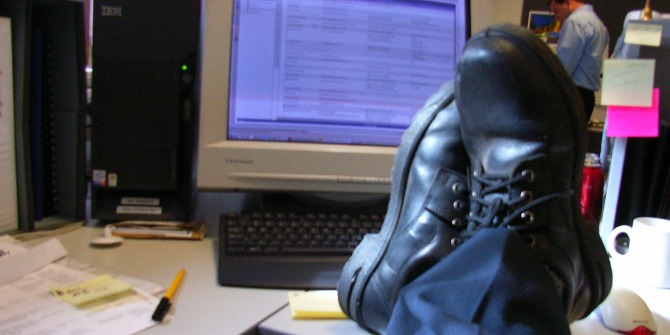
The changing landscape of technology-enabled connectivity is shifting how our work and personal lives interface, especially how we juggle work and non-work demands. In large part due to the ubiquitous nature of mobile devices that blur the boundaries between our work and personal lives, work has now become a significant presence in our life outside the workplace, interrupting our home and leisure activities.
It has become a new personal life norm to navigate our technologically suffused environment by constantly reprioritising and responding to work demands delivered via various communication channels (e.g., phone calls, emails, messaging, video conferencing). What effects do these after-hours work interruptions have on our work and our personal lives? Are they beneficial, detrimental, or both?
To answer these questions we conducted a study of U.S. knowledge workers to examine the effects of such technology-mediated, work-related interruptions that occur during one’s time off. We found both negative and positive effects. Negative effects are observed in terms of performance deterioration, work and non-work exhaustion, and the inability to psychologically disconnect from work.
First and foremost, after-hours work engagement via technology can jeopardise our ability to fulfil work and non-work commitments but only when the cumulative amount of work requests exceeds what we can handle using slack resources from our personal life. When we deplete all the slack resources in our personal lives to meet after-hours work demands, and we start tapping into critical resources needed to meet personal life commitments, both our work and personal life performance suffer.
Second, we also feel stressed, irritable, tense, and emotionally exhausted from these intruding work demands but also from our non-work demands that now must be met with fewer resources. Third, in an environment suffused with technology and work connectivity at our fingertips, we remain preoccupied with work, finding it increasingly difficult to psychologically disconnect from work. This can make us feel drained of emotional and mental energy.
In terms of the positive effects, we found that people do use technologies to engage in work activities during their time off for some good reasons. The flexibility to work anywhere and at any time, afforded by technology, enables us to bring our lingering work-related tasks and thoughts (e.g., a pestering concern due to an unresolved issue) to closure. This reduces preoccupation and allows us to disengage from work. However, such flexibility seems to be overly used or abused more often than not. Such positive effects fall short of reverting the negative effects we reported earlier.
Though we found both negative and positive effects associated with work engagement that intrudes into our home and leisure activities, the net effect is detrimental. The strongest negative net effect of work intrusion in our personal life is feeling fatigued and exhausted from work and unable to disengage and recharge.
The specific technology we choose to use for after-hours work engagement also determines the extent of positive and negative effects on our work and personal life. The asynchronous nature of email makes it less intrusive than phone calls (synchronous) and messaging (near-synchronous). Individuals on either side of a phone or messaging conversation do not have sole control over the duration, timing (when the conversation is initiated), or intensity of the conversation. As a result, while engaging in a work-related communication over the phone or through messaging, people can hardly delay responding to an opportune time without giving offence. Therefore, after-hours work engagement that occurs via phone call or messaging is more likely to overwhelm people by demanding too much of their attention at a moment when they may have a limited bandwidth.
With email communication, long gaps of silence is acceptable or even expected. Email processing is a solitary activity where people do not have to negotiate with communication partners on matters such as when to check emails and how much time to spend on emails. The greater latitude to control when and how to handle work emails allows us to choose a time when we have slack capacity in our personal life to accommodate these work demands. With such temporal distancing, we can manage our moment-to-moment availability in that email allows us to interweave email processing with a household task, as and when we have time, facilitating our efforts in bringing a work communication to closure. Instead of pressuring us to mentally compose a perfect version of what we intend to convey, email enables us to take smaller steps towards completing the message by making use of the amount of slack resources available of the moment when we are attending to the primary task. We can create a draft of the intended email communication at different points in time and later review it for content, grammatical errors and spelling before sending it to bring to closure unfinished communications.
However, the temporal distancing afforded by email can also give rise to unnecessarily prolonged or overly frequent engagement in processing work emails. It enables us to spend more time to compose, deliberate, or edit a message before sending it out, and to re-examine or re-interpret a message multiple times after it has been received. As a result, work can linger in our mind for a prolonged time or more frequently, which nurtures rumination. In fact, the negative and positive effects of email interruptions cancel each other out, leading to the net effect of work intrusion via email being almost neutral.
There is a fine line between effectively leveraging after-hours work connectivity and overusing it. In a world of constant connectivity, it is crucial that we learn how to sift through the many work demands that creep into our life outside of work via technologies and identify the ones that truly deserve our time, attention, and energies such as those that bring closure to unresolved work demands that preoccupy us and do not allow us to engage in our personal life.
In addition to personally being conscious of managing work intrusion into our personal life, technological solutions can enable users both to better manage how and when they are interrupted, and to make better use of their limited cognitive and attentional resources. Furthermore, organisational norms about after-hours technology use should also be consciously developed and carefully nurtured in terms of what, when, and how to intrude into employees’ personal spheres.
♣♣♣
Notes:
- This blog post is based on the authors’ paper Life Interrupted: Examining the Effects of Work-Related Technology-Mediated Interruptions on Work and Life Outcomes, forthcoming at the MIS Quarterly.
- The post gives the views of its authors, not the position of LSE Business Review or the London School of Economics.
- Featured image credit: Mobiles by a wall, by Garry Knight, under a CC-BY-2.0 licence
- When you leave a comment, you’re agreeing to our Comment Policy
 Adela Chen is an Assistant Professor of Information Systems at the College of Business, Colorado State University. Her research focuses on the impact of technology use on people’s work and personal life, and the role of information systems in environmental sustainability.
Adela Chen is an Assistant Professor of Information Systems at the College of Business, Colorado State University. Her research focuses on the impact of technology use on people’s work and personal life, and the role of information systems in environmental sustainability.
 Elena Karahanna is Distinguished Research Professor and the L. Edmund Rast Professor of Business in the MIS Department at the Terry College of Business, University of Georgia. Her research focuses on the use of information systems, health IT, IS leadership, social media, and cross-cultural issues. She was named AIS Fellow in 2012.
Elena Karahanna is Distinguished Research Professor and the L. Edmund Rast Professor of Business in the MIS Department at the Terry College of Business, University of Georgia. Her research focuses on the use of information systems, health IT, IS leadership, social media, and cross-cultural issues. She was named AIS Fellow in 2012.





